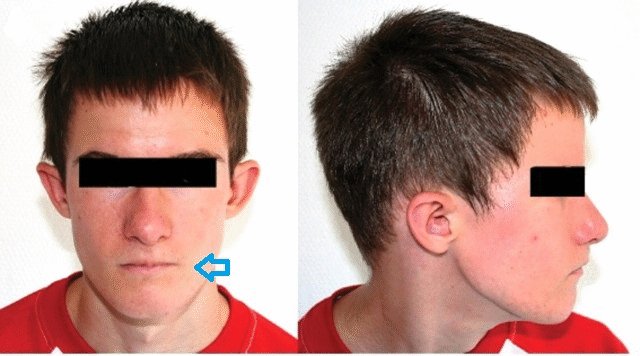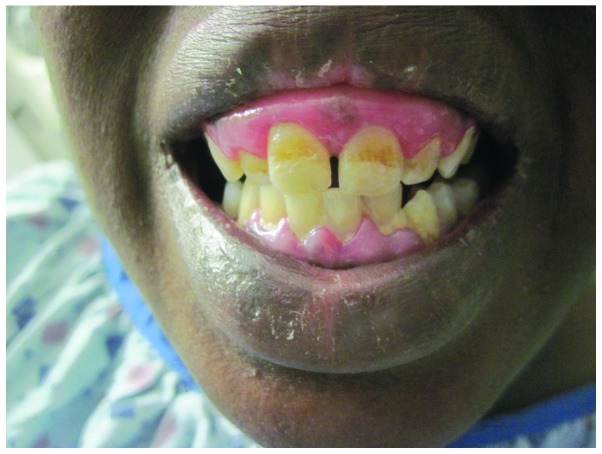Andersen-Tawil syndrome physical examination: Difference between revisions
Jump to navigation
Jump to search
(→HEENT) |
(→HEENT) |
||
| Line 21: | Line 21: | ||
*Broad nose may be seen | *Broad nose may be seen | ||
*Dental abnormalities: Lax jaw and poor dentition. | *Dental abnormalities: Lax jaw and poor dentition. | ||
*[[ | * [[Hypertelorism]] (widely spaced eyes) may be noted on physical examination of the patients with Andersen-Tawil syndrome | ||
[[File:Facial dysmorphia.gif|alt=Facial dysmorphia|thumb|Facial dysmorphia. The mouth is small(purple arrow), the ears have low implantation(yellow arrow) and the nose ridge is broad(blue arrow). Case courtesy by Stéphane Burtey et al<ref>{{Cite web|url=https://www.ncbi.nlm.nih.gov/pmc/articles/PMC4421201/|title=Hypokalaemia and dysmorphia, is there a link?|last=|first=|date=|website=|archive-url=|archive-date=|dead-url=|access-date=}}</ref>|center]]<br /> | [[File:Facial dysmorphia.gif|alt=Facial dysmorphia|thumb|Facial dysmorphia. The mouth is small(purple arrow), the ears have low implantation(yellow arrow) and the nose ridge is broad(blue arrow). Case courtesy by Stéphane Burtey et al<ref>{{Cite web|url=https://www.ncbi.nlm.nih.gov/pmc/articles/PMC4421201/|title=Hypokalaemia and dysmorphia, is there a link?|last=|first=|date=|website=|archive-url=|archive-date=|dead-url=|access-date=}}</ref>|center]]<br /> | ||
[[File:Dental abnormalities.jpg|alt=Dental abnormalities|center|thumb|Dental abnormalities in patient with Andersen-Tawil syndrome. Case courtesy by Rui Fan et al<ref>{{Cite web|url=https://www.ncbi.nlm.nih.gov/pmc/articles/PMC5038206/|title=Concomitant presentation of Anderson-Tawil syndrome and myasthenia gravis in an adult patient: A case report|last=|first=|date=|website=|archive-url=|archive-date=|dead-url=|access-date=}}</ref> ]]<br /> | |||
=== '''Heart''' === | === '''Heart''' === | ||
Revision as of 16:29, 7 February 2020
|
Andersen-Tawil syndrome Microchapters |
|
Diagnosis |
|---|
|
Treatment |
|
Case Studies |
|
Andersen-Tawil syndrome physical examination On the Web |
|
American Roentgen Ray Society Images of Andersen-Tawil syndrome physical examination |
|
Risk calculators and risk factors for Andersen-Tawil syndrome physical examination |
Editor-In-Chief: C. Michael Gibson, M.S., M.D. [1]; Associate Editor(s)-in-Chief: Charmaine Patel, M.D. [2]; Raviteja Guddeti, M.B.B.S. [3]
Overview
Patients with Andersen-Tawil syndrome usually appear shorter than normal. Physical examination of patients with Andersen-Tawil syndrome is usually remarkable for hypoplastic mandible, micrognathia, broad nose, low set ears and clinodactyly.
Physical Examination
Appearance of the Patient
- Patients with Andersen-Tawil syndrome usually appear shorter than normal.
HEENT
Findings may include:
- Hypoplastic mandible or small mandible
- Micrognathia
- Low-set ears
- Broad nose may be seen
- Dental abnormalities: Lax jaw and poor dentition.
- Hypertelorism (widely spaced eyes) may be noted on physical examination of the patients with Andersen-Tawil syndrome


Heart
- Palpitations.
- Syncope is usally seen in the first or second decade of the life of the patient
- Andersen-Tawil syndrome patients have a unique cardiac finding on ECG
Neuromuscular
- Periodic paralysis:[3][4][5][6][7]
- The most important clinical manifestation of Andersen-Tawil syndrome patients is periodic paralysis
- Periodic paralysis are episodic paralysis with flaccid muscle weakness
- These periodic paralysis impairs quality of life of the patients with Andersen-Tawil syndrome
- Triggers often may be due to change in behavior or diet, and also due to the fact that alterations in serum potassium levels.
- Muscle weakness:[8]
- In patients with Andersen-Tawil syndrome the muscle weakness occurs intermittently or spontaneously
- Muscle weakness in patients with Andersen-Tawil syndrome may be occured due to prolonged rest or rest following exertion
- Neuromuscular examination of patients with [disease name] is usually normal.
OR
- Patient is usually oriented to persons, place, and time
- Altered mental status
- Glasgow coma scale is ___ / 15
- Clonus may be present
- Hyperreflexia / hyporeflexia / areflexia
- Positive (abnormal) Babinski / plantar reflex unilaterally/bilaterally
- Muscle rigidity
- Proximal/distal muscle weakness unilaterally/bilaterally
- ____ (finding) suggestive of cranial nerve ___ (roman numerical) deficit (e.g. Dilated pupils suggestive of CN III deficit)
- Unilateral/bilateral upper/lower extremity weakness
Extremities
- Clinodactyly:[9]
- Fifth-digit clinodactyly
- Second and third toe syndactyly
References
- ↑ "Hypokalaemia and dysmorphia, is there a link?".
- ↑ "Concomitant presentation of Anderson-Tawil syndrome and myasthenia gravis in an adult patient: A case report".
- ↑ Levitt, Lawrence P.; Rose, Leslie I.; Dawson, David M. (1972). "Hypokalemic Periodic Paralysis with Arrhythmia". New England Journal of Medicine. 286 (5): 253–254. doi:10.1056/NEJM197202032860507. ISSN 0028-4793.
- ↑ Statland JM, Fontaine B, Hanna MG, Johnson NE, Kissel JT, Sansone VA; et al. (2018). "Review of the Diagnosis and Treatment of Periodic Paralysis". Muscle Nerve. 57 (4): 522–530. doi:10.1002/mus.26009. PMC 5867231. PMID 29125635.
- ↑ Cavel-Greant D, Lehmann-Horn F, Jurkat-Rott K (2012). "The impact of permanent muscle weakness on quality of life in periodic paralysis: a survey of 66 patients". Acta Myol. 31 (2): 126–33. PMC 3476862. PMID 23097604.
- ↑ Sansone VA, Ricci C, Montanari M, Apolone G, Rose M, Meola G; et al. (2012). "Measuring quality of life impairment in skeletal muscle channelopathies". Eur J Neurol. 19 (11): 1470–6. doi:10.1111/j.1468-1331.2012.03751.x. PMC 3492909. PMID 22607270.
- ↑ Modoni A, Bianchi ML, Vitulano N, Pagliarani S, Perna F, Sanna T; et al. (2011). "Lack of any cardiac involvement in a patient with Andersen-Tawil syndrome associated with the c.574A→G mutation in KCNJ2". Cardiology. 120 (4): 200–3. doi:10.1159/000335529. PMID 22286118.
- ↑ Andersen ED, Krasilnikoff PA, Overvad H (1971). "Intermittent muscular weakness, extrasystoles, and multiple developmental anomalies. A new syndrome?". Acta Paediatr Scand. 60 (5): 559–64. doi:10.1111/j.1651-2227.1971.tb06990.x. PMID 4106724.
- ↑ Tawil R, Ptacek LJ, Pavlakis SG, DeVivo DC, Penn AS, Ozdemir C; et al. (1994). "Andersen's syndrome: potassium-sensitive periodic paralysis, ventricular ectopy, and dysmorphic features". Ann Neurol. 35 (3): 326–30. doi:10.1002/ana.410350313. PMID 8080508.